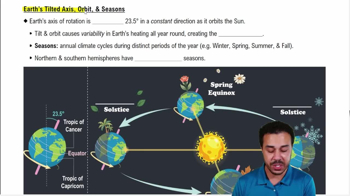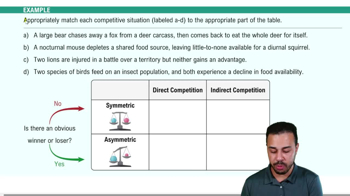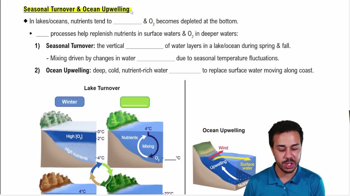Table of contents
- 1. Introduction to Biology2h 40m
- 2. Chemistry3h 40m
- 3. Water1h 26m
- 4. Biomolecules2h 23m
- 5. Cell Components2h 26m
- 6. The Membrane2h 31m
- 7. Energy and Metabolism2h 0m
- 8. Respiration2h 40m
- 9. Photosynthesis2h 49m
- 10. Cell Signaling59m
- 11. Cell Division2h 47m
- 12. Meiosis2h 0m
- 13. Mendelian Genetics4h 41m
- Introduction to Mendel's Experiments7m
- Genotype vs. Phenotype17m
- Punnett Squares13m
- Mendel's Experiments26m
- Mendel's Laws18m
- Monohybrid Crosses16m
- Test Crosses14m
- Dihybrid Crosses20m
- Punnett Square Probability26m
- Incomplete Dominance vs. Codominance20m
- Epistasis7m
- Non-Mendelian Genetics12m
- Pedigrees6m
- Autosomal Inheritance21m
- Sex-Linked Inheritance43m
- X-Inactivation9m
- 14. DNA Synthesis2h 27m
- 15. Gene Expression3h 20m
- 16. Regulation of Expression3h 31m
- Introduction to Regulation of Gene Expression13m
- Prokaryotic Gene Regulation via Operons27m
- The Lac Operon21m
- Glucose's Impact on Lac Operon25m
- The Trp Operon20m
- Review of the Lac Operon & Trp Operon11m
- Introduction to Eukaryotic Gene Regulation9m
- Eukaryotic Chromatin Modifications16m
- Eukaryotic Transcriptional Control22m
- Eukaryotic Post-Transcriptional Regulation28m
- Eukaryotic Post-Translational Regulation13m
- 17. Viruses37m
- 18. Biotechnology2h 58m
- 19. Genomics17m
- 20. Development1h 5m
- 21. Evolution3h 1m
- 22. Evolution of Populations3h 52m
- 23. Speciation1h 37m
- 24. History of Life on Earth2h 6m
- 25. Phylogeny2h 31m
- 26. Prokaryotes4h 59m
- 27. Protists1h 12m
- 28. Plants1h 22m
- 29. Fungi36m
- 30. Overview of Animals34m
- 31. Invertebrates1h 2m
- 32. Vertebrates50m
- 33. Plant Anatomy1h 3m
- 34. Vascular Plant Transport2m
- 35. Soil37m
- 36. Plant Reproduction47m
- 37. Plant Sensation and Response1h 9m
- 38. Animal Form and Function1h 19m
- 39. Digestive System10m
- 40. Circulatory System1h 57m
- 41. Immune System1h 12m
- 42. Osmoregulation and Excretion50m
- 43. Endocrine System4m
- 44. Animal Reproduction2m
- 45. Nervous System55m
- 46. Sensory Systems46m
- 47. Muscle Systems23m
- 48. Ecology3h 11m
- Introduction to Ecology20m
- Biogeography14m
- Earth's Climate Patterns50m
- Introduction to Terrestrial Biomes10m
- Terrestrial Biomes: Near Equator13m
- Terrestrial Biomes: Temperate Regions10m
- Terrestrial Biomes: Northern Regions15m
- Introduction to Aquatic Biomes27m
- Freshwater Aquatic Biomes14m
- Marine Aquatic Biomes13m
- 49. Animal Behavior28m
- 50. Population Ecology3h 41m
- Introduction to Population Ecology28m
- Population Sampling Methods23m
- Life History12m
- Population Demography17m
- Factors Limiting Population Growth14m
- Introduction to Population Growth Models22m
- Linear Population Growth6m
- Exponential Population Growth29m
- Logistic Population Growth32m
- r/K Selection10m
- The Human Population22m
- 51. Community Ecology2h 46m
- Introduction to Community Ecology2m
- Introduction to Community Interactions9m
- Community Interactions: Competition (-/-)38m
- Community Interactions: Exploitation (+/-)23m
- Community Interactions: Mutualism (+/+) & Commensalism (+/0)9m
- Community Structure35m
- Community Dynamics26m
- Geographic Impact on Communities21m
- 52. Ecosystems2h 36m
- 53. Conservation Biology24m
48. Ecology
Introduction to Ecology
Problem 5a
Textbook Question
The solar equator, the region of Earth where the sun is directly overhead, moves from 23.5°N to 23.5°S latitudes and back over the course of a year. Why? a. Earth wobbles on its axis during the year; b. The position of the poles changes by this amount annually; c. Earth's axis is 23.5° from perpendicular to the rays of the sun; d. Earth moves 23.5° toward the sun in summer and 23.5° away from the sun in winter; e. Ocean currents carry heat from the tropical ocean north in summer and south in winter
 Verified step by step guidance
Verified step by step guidance1
Identify the key concept: The movement of the solar equator from 23.5°N to 23.5°S is related to Earth's orientation and movement in relation to the sun.
Understand Earth's axial tilt: Earth's axis is tilted at an angle of approximately 23.5° relative to its orbit around the sun. This tilt is responsible for the seasonal variations and the shifting of the solar equator.
Analyze the options: Consider how each provided option relates to Earth's axial tilt and the movement of the solar equator.
Eliminate incorrect options: Options that do not directly relate to Earth's axial tilt or imply incorrect changes in Earth's physical properties (like wobbling or moving towards the sun) should be considered incorrect.
Select the correct option: Choose the option that correctly explains the impact of Earth's axial tilt on the movement of the solar equator.
Recommended similar problem, with video answer:
 Verified Solution
Verified SolutionThis video solution was recommended by our tutors as helpful for the problem above
Video duration:
1mPlay a video:
Was this helpful?
Key Concepts
Here are the essential concepts you must grasp in order to answer the question correctly.
Axial Tilt
Earth's axis is tilted at an angle of approximately 23.5° relative to its orbital plane around the sun. This axial tilt is responsible for the changing seasons as different parts of the Earth receive varying amounts of sunlight throughout the year. The solar equator shifts between 23.5°N and 23.5°S as the Earth orbits the sun, leading to the phenomenon of the sun being directly overhead at different latitudes during different times of the year.
Recommended video:
Guided course

Earth’s Tilted Axis, Orbit, & Seasons
Solar Declination
Solar declination refers to the angle between the rays of the sun and the plane of the Earth's equator. As the Earth orbits the sun, the solar declination changes, causing the sun to be directly overhead at different latitudes. This movement of the solar equator from 23.5°N to 23.5°S and back is a direct result of the Earth's axial tilt and its orbit, influencing seasonal weather patterns and daylight hours.
Recommended video:
Guided course

Community Interactions: Competition (-/-) Example 1
Seasons
Seasons are the result of the Earth's axial tilt and its orbit around the sun, leading to variations in sunlight intensity and duration at different latitudes. During summer in one hemisphere, that region tilts toward the sun, resulting in longer days and more direct sunlight, while the opposite hemisphere experiences winter. This cyclical pattern of seasons is what causes the solar equator to shift between 23.5°N and 23.5°S throughout the year.
Recommended video:
Guided course

Seasonal Turnover & Ocean Upwelling

 2:54m
2:54mWatch next
Master What is Ecology? with a bite sized video explanation from Jason Amores Sumpter
Start learningRelated Videos
Related Practice































































































